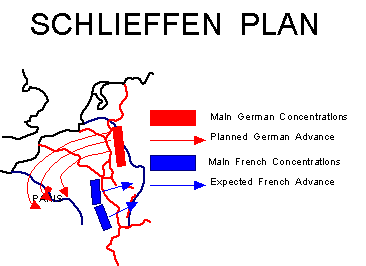- Created by General Count Alfred von Schlieffen, December 1905
- Plan worked in the event of an attack on France one Russia had started to mobilize forces near the German border.
- In 1905, Shlieffen was chief of the German General Staff.
- Schlieffen believed that the most decisive area for any future war in Europe would be in the western sector.
- Identified France as Germany’s most dangerous opponent.
- Russia was not as advanced and would take six weeks to mobilize, and that any possible fighting on the Russian-German border could be coped with by the Germans for a few weeks while the bulk of forces concentrated on beating France.
- Schlieffen believed that a massive and successful surprise attack against France would be enough to put off Britain becoming involved.
- This would allow Germany time (the six weeks that were built into the plan) to transfer soldiers who had been fighting in the successful French campaign to Russia to fight the Russians.
- Plan was to go through Belgium and Luxembourg. Belgium had had neutrality guaranteed by Britain in 1839 – strategy depends on Britain not supporting Belgium.
- Plan to send a small force straight across the France-Germany border to attract the French troops, then pull back into the mountains while a larger German force moved through Belgium and swing wide around Paris and end up behind the French army.
- Schlieffen realizes that invading through Belgium will bring other nations into the fight, but he believed that it was worth the risk.
- Germany fails to score the victory which eliminates the opportunity for a short war.
- Plan was Daring but had weaknesses
- The actions of Russia determined when Germany would have to start her attack on France, even if Germany was not ready.
- It assumed that Russia would need six weeks to mobilize.
- Assumes that Germany would defeat France in less than six weeks.

